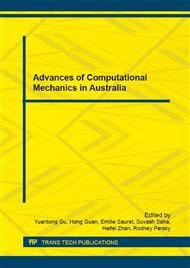p.378
p.385
p.391
p.397
p.403
p.409
p.415
p.421
p.428
A Fractional Generalised Finite Difference Method to Linear Porous Media Dynamics
Abstract:
The generalised finite difference method (GFDM) is a mesh-free method for solving partial differential equations (PDEs) in non-structured grids. Due to its strong theoretical background and simplicity, hence efficiency, it has been introduced to handle interesting and sophisticate engineering problems. However, the GFDM has not been applied to problems associated to dynamics of porous media yet. In these problems, the strong coupling between solid displacements and liquid pressures may cause large numerical oscillations if equal order interpolation functions are used for both variables. Nevertheless, some fractional steps techniques can be introduced in order to minimise these problems. In this contribution, a fractional steps scheme is developed and applied to the GFDM in order to model fully saturated porous media dynamics. Simulations of 1D and 2D wave propagation are performed in order to reveal the advantages, drawbacks and capabilities of the proposed method.
Info:
Periodical:
Pages:
403-408
Citation:
Online since:
July 2016
Authors:
Price:
Сopyright:
© 2016 Trans Tech Publications Ltd. All Rights Reserved
Share:
Citation:


